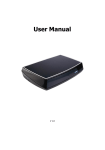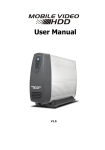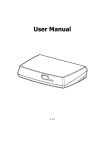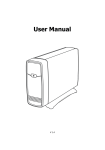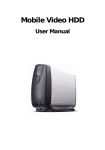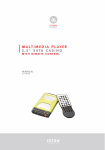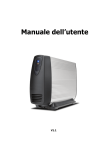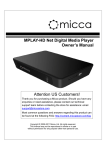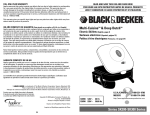Download Argosy HV372T
Transcript
User Manual V 1.1 CONTENTS Introduction .............................................................................1 Features ................................................................................................1 System Requirements .............................................................................1 The Remote Control..................................................................2 Removing and Storing the Remote Control...............................................2 Using the Remote Control for the First Time.............................................2 Changing the Battery of the Remote Control ............................................2 Buttons ..................................................................................................3 Parts and Functions ..................................................................4 Quick Start...............................................................................5 PC Connection ..........................................................................6 Introduction ...........................................................................................6 Software Installation...............................................................................6 Connecting to USB..................................................................................6 Disconnecting from USB..........................................................................7 About the Format of Hard Disk Drive .......................................................8 Media Files for Playback ..........................................................................8 Using the Utility Programs.......................................................................9 About Partitioning the Hard Disk Drive ................................................... 13 TV Connection........................................................................ 15 Connecting to AV Equipments ............................................................... 15 Mounting the USB External Storage ....................................................... 17 Using the AV Playback Function ............................................... 19 Browsing Media Files ............................................................................ 19 Using Private Folder.............................................................................. 20 Using the Remote Control ..................................................................... 21 Setup Menu............................................................................ 27 GENERAL SETUP .................................................................................. 27 AUDIO SETUP ...................................................................................... 27 VIDEO SETUP....................................................................................... 28 PREFERENCES SETUP ........................................................................... 29 Appendix ............................................................................... 30 Specifications ....................................................................................... 30 Error Code ........................................................................................... 31 Fonts support country list...................................................................... 31 Copyright and Trademarks .................................................................... 32 Introduction Introduction Features Plays back DVD Folder/ DVD ISO, VCD, MPEG1, MPEG2, Xvid (AVI) movie files, MP3, WAV, WMA, OGG music files, JPEG photo and graphic files. Supports NTFS/FAT32/HFS+ file system. Supports both NTSC and PAL TV systems. Supports video output up-scaling to 720p/1080i. Supports HDMI and component video output. Supports Music Slideshow. Supports bilingual subtitle display. • This device is not for in-car entertainment use. Unstable power or vibration may damage this device. • Do not use an AC adapter other than the one came along with the retail package; any damage caused by unauthorized adapters will avoid warranty. • Always check that files have been copied to the device successfully. Always keep two copies of important files (an original and a backup). We are not responsible for data loss or damage during file transfer or while store on the device. • Moving the hard disk while it is still in operation may damage the hard disk. We are not liable for any data loss or damage caused by inappropriate or careless use. • It is recommended to unplug the unit from the power socket completely when not in use. TV screen does not display normally: • Press TV SYS button to switch output TV system. (See page 29 for more detail). System Requirements A desktop or notebook PC with USB 1.1/2.0 port Operating systems: Windows 7 / Vista / XP / 2000 Storage medium: A 3.5” SATA HDD 1 The Remote Control The Remote Control Removing and Storing the Remote Control This device is designed with a remote control storage compartment at the bottom. You can store the remote control in the compartment to avoid misplacing. Using the Remote Control for the First Time For the first time use of the remote control, pull out the tab to enable the battery power of the remote control. Changing the Battery of the Remote Control If the battery becomes depleted, change the battery according to the following instructions: 1. Turn the remote control on its back, and then press the tab on the left side with fingernailn. Hold and pull Take out the battery holder at the indentationo to take out the battery unit. 2. The battery model of this remote control is CR2025. Refer to the illustration to insert the battery accurately Load the new battery (+ towards up) with the positive terminal facing up – see illustration below. 3. Place the new battery and make sure it is inserted and seated securely. Insert the battery holder 2 The Remote Control Buttons 1 ○ STANDBY: Activate this device / Return to Standby 2 TV SYS ○ Switch output TV system 3 SETUP: ○ Enter Setup Menu 4 ○ SOURCE: No function 5 AUDIO: ○ Switch audio channels 6 SUBTITLE: ○ Switch DVD / Xvid subtitles 7 ANGLE: ○ Switch DVD angles 8 ZOOM: ○ No function 9 ○ RETURN: Return to parental folder 10 SLOW: ○ Slow motion playback 11 ○ No function REC: 12 DELETE: ○ No function : Cursor keys 13 ○ 14 ○ ENTER: Play/Pause the current selected file or folder. 15 ○ HOME: Open Home Menu. 16 MENU: ○ Open DVD main menu 17 ○ Stop current playback STOP: 18 ○ / : Fast rewind / Fast forward 19 ○ / : Play the previous / next file 20 0~9: ○ Number pad 21 DISPLAY: ○ Display file properties / played time (page 26) 22 GOTO: ○ Search by Title / Time (page 25) 23 A-B: ○ Repeat from A to B (page 25) 24 REPEAT: ○ Change the play mode (page 25) 25 ○ / : Volume up / Volume down (page 23) 3 Parts and Functions Parts and Functions 1 ○ Remote receiver : When using the remote, point the remote towards here. 2 ○ Power and access Lights up: The power is on. indicator (blue) : 3 ○ USB type A connector : Blinking: Booting up/ Accessing data through PC connection. Connect to a USB Flash drive or a USB external HDD. (USB card reader support is not guaranteed) 4 ○ Coaxial digital audio connector : 5 ○ Power switch : Outputs S/PDIF digital audio signal. Connect this jack to an AV receiver with a RCA cable. (cable not provided) Press this button to turn on this device. Press this button for about 1 second to turn it off. 6 ○ Composite audio/video output connector : 7 ○ Component video output connector : 8 ○ USB type B connector : 9 ○ HDMI connector : Output composite video/audio signals. The colors of the jacks are yellow, red and white. Output component video signals. The colors of the jacks are green, blue and red. Connecting this device with a PC using a USB cable. Outputs digital video/audio signals with a HDMI cable. (cable not provided) 10 ○ Kensington Security Slot : Connects to a Kensington lock pin. 11 ○ Power connector : 4 Connect to the AC adapter. (DC 12V, 2A) Quick Start Quick Start Read before use. 1. Do not operate electronics with wet hands. 2. Do not operate this device in a bathroom. 3. Do not bend cables in a sharp angle. 4. Keep this device unreachable from children. 5. Keep this device and its accessories away from heat sources. How do I use this device? Copy media files from your computer to this device, and then connect it to your TV or Home Theater. The User Interface is somewhat intuitive like a Browser. Try starting with and buttons. How do I copy media files into it? 1. Make sure that this device had been correctly formatted. 2. Plug the USB cable and the AC adapter. 3. Press the Power Switch to turn it on. 4. Copy files just like using a USB external HDD. You can do it with Windows Explorer or Mac OS Finder. (No additional software is needed!) How do I play media files on my TV? 1. Connect this device to your TV with correct cables. 2. Plug the AC adapter into the Power Connector and press the Power Switch to turn it on. 3. Press the STANDBY button on the remote control to activate this device. 4. Browse with and buttons. What if my TV screen displays unstable image? Press the TV SYS button to switch output TV system. (See page 29 for more detail) How to configure settings? Press the SETUP button. What if I have more questions to ask? Please read detailed descriptions in this manual. 5 PC Connection PC Connection Introduction According to your operation system, read the following information: OS support Windows Windows Windows Windows 7 Vista XP 2000 USB Connection ∨ ∨ ∨ ∨ NTFS ∨ ∨ ∨ ∨ FAT32 ∨ ∨ ∨ ∨ HFS+ Mac OS Linux ∨ ∨ ∨ ∨ ∨ Private Folder Manager ∨ ∨ ∨ Playlist Manager ∨ ∨ ∨ • Some USB 2.0 Host Controllers may require updated device driver files to operate properly. If you have problems with your USB connection, visit the Windows Update web site to make sure you have the latest Service Packs and device drivers installed on your PC before contacting technical support. Software Installation 1. Do not connect this device to computer yet. 2. Insert the utility CD into computer’s optical drive, and then the installation window should automatically appear on the screen. If the installation window doesn’t show up, go to “My Computer” and browse the CD. By executing the “index.html” file, the installation window will appear. 3. Click on “Private Folder Manager”/ “Playlist Manager”, and then follow the on screen instructions for installation. 4. After the software had been successfully installed, see [Connecting to USB] for cable connection. Connecting to USB 1. Connect the plug of AC adapter to the connector marked “DC IN”, plug the other end into an electric outlet. 2. Connect the USB cable to the USB connector. Then connect the other plug to computer’s USB port. 3. Press the Power switch and then the blue LED will light up. 4. The computer will detect this device and you can start accessing the drive. 6 PC Connection Disconnecting from USB When you are ready to disconnect this device from PC, follow these steps: 1. Close all the programs that are accessing this device. 2. Close all Explorer windows which display the content of this device. 3. Click the Safely Remove Hardware icon ( , or ) on the System Tray and select the drive letter assigned to this device. When the system message “safely removed” appears, unplug the USB cable from the computer. 7 PC Connection About the Format of Hard Disk Drive You can directly access this drive after it is connected to PC. If you want to re-partition the HDD, please note: Player mode HDD mode Access First primary partition only No limitation File system NTFS, FAT32, HFS+ No limitation See [About Partitioning the Hard Disk Drive] section (page 13) to create or to change the partition. For more information about file systems, please read the following: OS support NTFS FAT32 HFS+ Mac OS Windows 7/ Windows 7/Vista/XP/ Vista/XP/2000 2000/Me /98SE, Mac OS Single file size limitation 2TB 4GB 2TB Partition size limitation 2TB 2TB (Windows 7/Vista/ 2TB XP/ 2000: 32GB) Media Files for Playback When using this device as a media player, it can only browse and play back some specific media file formats. This device can play back the following media files: DVD movie files / DVD ISO Xvid movie files: The filename extensions are avi, xvid Xvid subtitle files: The filename extensions are srt, sub, idx/sub, smi, psb, ass, ssa VCD files: The filename extension is dat MPEG1 / MPEG2 files: The filename extensions are mpg, mpe, mpeg, m2p, vob Audio and music files: The filename extensions are wav, mp3, wma, ogg Photo and graphic files: The filename extensions are jpg, jpe, jpeg • If your files are larger than 4GB. You’ll need to format this device in NTFS/HFS+ for storing large files. • If your file has any of the following attributes attached to it, you may find it missing: “Hidden”, “Encrypted”, “Compressed” and “System Folder” Media Files Not Supported Some media files, such as WMV, ASF or MOV files, can’t be played back with this device. Please use video convert software to convert these files into MPEG1, MPEG2, or Xvid format. Then copy the converted files into the folders in this device. 8 PC Connection Using the Utility Programs The utility programs contain “Playlist Manager” and “Private Folder Manager”. Feature OS support Private Folder Manager Playlist Manager Set specific folders in this device as “Locked Create a collection of Folders”, which will not be displayed on TV or PC media files which can be operation until a correct password is entered. played in series. Windows 7/Vista/XP Windows 7/Vista/XP Using Playlist Manager If your OS is Windows 7/Vista/XP, you can use the Playlist Manager Utility to create Playlists consist of blending video, audio, and photo files. A total 2048 files can be added to a single Playlist. Note: A Playlist is a .m3u file; you can also use the .m3u file established by other software players, such as Windows Media Player or Winamp. If you find your Playlist missing during TV operation, open it with our Playlist Manager and save it again. 1. Connecting this device to computer: Click on “Start” Ö “All Programs” (Vista: “Programs”) Ö “Private Folder & Playlist” Ö “Playlist Manager” to launch the utility. 2. Creating a new Playlist: Selecting the drop list <File> Ö <New Playlist>. The newly created Playlist in the lower column can then be named as wish. 9 PC Connection 3. Adding files to your Playlist: Browse and select the files that you would like to add in your Playlist from the upper column, and then press the button. 4. Removing files from your Playlist: Browse and select the files that you would like to remove from your Playlist from the lower column, and then press the button. 5. Adjusting the Playlist sequence: Select the files that you want to manage and use or button to move them a step forward or backward in the Playlist. 6. Selecting the play mode: There are five modes available. i. Normal: Play from the first of the list down to the end of the list. ii. Repeat One: Play the first file repeatedly. Press Next to play the next file repeatedly. It is especially useful for briefing presentation purpose. iii. Repeat All: Play in normal mode and repeat the entire list after the last file had been played. iv. Shuffle: Randomly play the files in the list once. v. Shuffle Repeat: Play in shuffle mode and repeat the list after all files in the list had been played once. Using Private Folder Manager 1. Connect this device to computer: Click on “Start” Ö “All Programs” (Vista: “Programs”) Ö “Private Folder & Playlist” (Windows Me/98SE: “Private Folder”)Ö “Private Folder Manager” to launch this utility. 2. This utility will automatically detect devices connected to this computer. Choose the drive letter you want to setup from the “Drive” at the top of the utility window if you have mounted more than one device. 3. The folders under the “ROOT” folder will be listed in its window. Setting the Folders as “Locked Folders” You can create “Locked Folders” which will not be displayed on TV when using this device as a media player, and will not be displayed during PC operation either. 1. Choose the drive if necessary. 2. Use cursor to select the folders for following operation. 3. Click “Mark as Locked” button. It will add a lock icon next to the folder name. These operations will take place immediately after the button is pressed. 4. Input 4 digits of number in the “Password” field. 5. After finishing above settings, click “Exit” button to exit this utility. You will need to input the same password for next launch of this utility. 10 PC Connection Displaying the “Locked Folders” 1. When using this device as a media player, you need to use the remote control to input the password (as your previous setting) under the ROOT folder for displaying these folders you’ve marked as Locked. (The icon will appear on the screen each time you press those buttons.) 2. After the password is entered, these locked folders will be shown in a folder named after the Private Folder Name, default as “v folder”. You can also change the name as your wish. 3. If you need to display these locked folders during PC operation, follow the next paragraph to set them as “Public Folders”. Note: You may refer to the [Using the AV Playback Function] - [Using Private Folder] section (page 20) for more information. Setting the Folders as “Public Folders” 1. Choose the drive if necessary. 2. Use cursor to select the folders for the following operation. 3. Click “Mark as Public” button. This will remove the lock icon next to the folder name. These operations will take effect immediately after the button is pressed. 4. After finishing above settings, click “Exit” button to exit this utility. 11 PC Connection If you forget your password 1. Open the “v folder” folder in this device 2. Open the text file “copyright.txt” with any text editing program. 3. Find the “FORGOT USER PASSWORD” section, and then follow the description there to recover your password. Do NOT delete, rename or edit the “v folder” and the files in it; nor the “Mplay.sys” file in “Root” folder of this device. Or, your data stored in “v folder” will be permanently lost. 12 PC Connection About Partitioning the Hard Disk Drive Partitioning the Hard Disk Drive under Windows Vista/XP/2000 This device will not function when initialized as a “Dynamic” disk type. Always use it with the “Basic” disk type. 1. Click “Start” Ö “Settings” Ö “Control Panel” Ö “Administrative Tools” Ö “Computer Management”. This will open the Computer Management Window. 2. Click on “Disk Management”, all disk drives currently connected to the system will be listed on the right side. Find out the Disk # which indicates this device. If the hard disk drive is a new, un-partitioned disk, a “Stop” sign next to the disk will indicate this drive as an “Unknown” type of drive. In this situation, Windows will not allow you to create a partition on this disk. • In Windows Vista: right-click on the “Stop” mark, then select “Initialize Disk” to initialize the disk. Select the MBR partition style, and then follow the steps to create a new partition. • In Windows XP: right-click on the “Stop” mark, then select “Initialize Disk” to initialize the disk. After the initialization of the disk, refer to the following steps to create a new partition. • In Windows 2000: Windows will start up the “Write Signature and Upgrade Disk Wizard” immediately. Use this wizard to initialize the hard disk to “Basic” disk type, and then follow the steps to create a new partition. 3. To delete an existing partition, right-click on the drive and select “Delete Partition”. Note: Delete a partition will also erase all data stored within the partition! 4. To create a new partition, right-click on the drive and select New Partition (Vista: New Simple Volume). This will open the New Partition Wizard (Vista: New Simple Volume Wizard). Click “Next” to start the wizard. 5. Select “Primary Partition” and click “Next”.(Vista will omit this step). 6. Set the partition size: Windows 7/Vista/XP/2000 “Disk Management” can only create FAT32 partitions smaller than 32768MB). You can create a NTFS partition of any size. 7. Assign a drive letter to it and click “Next”. 8. Set the file system to FAT32 or NTFS and click “Next”. 9. Click “Next” to confirm settings. 10. Click “Finish” to close the wizard and to start the partitioning and formatting process. 13 PC Connection Partitioning the Hard Disk Drive under Windows Me/98SE FDISK is a program to create partitions on the hard disk drive. (Data can only be written to a drive after it is partitioned and formatted). To partition this device, you must execute FDISK under the MS-DOS mode. Please follow these steps: 1. Install this device under Windows, and confirm that it is properly detected by the operating system. 2. Go into the MS-DOS mode by clicking on “Start” Ö “Programs” Ö “MS-DOS Prompt”. 3. At the DOS prompt, type “FDISK” and press Enter key. 4. In the first screen, answer “Y” to enable large disk support. 5. The next screen is “FDISK OPTIONS”. You must type “5” on this screen to change the current fixed disk drive; the default fixed drive set by FDISK is the internal hard disk drive. If you do not change it to this device, the data of internal hard disk drive will be destroyed. If the option 5 does not appear on this screen, it means this device is not installed properly, please check its installation. 6. In “Change Current Fixed Disk Drive” screen, type the disk drive number that is assigned to this device (usually, it is assigned to number 2). 7. Go back to “FDISK OPTIONS” screen, now you can create (type “1”) or delete (type “3”) the partition of the drive. Note: Delete a partition will also erase all data stored within the partition! 8. Follow the instructions of FDISK to create a new “Primary” partition. Accepting the default values will create the largest FAT32 partition possible. 9. After you finished FDISK, reboot computer to activate the change. 14 TV Connection TV Connection Connecting to AV Equipments HDMI Connection The HDMI connector can output both digital audio/video signals. Many HDTV sets and digital AV receivers support this type of connection. (HDMI cable not provided) To a TV: To an AV receiver: If the HDMI cable is disconnected in playback, this device will stop playback immediately. Note: • If you connect the HDMI cable during playback, you will have to press STOP button to return to Home Menu. • Some TV sets are equipped with DVI input ports, which will receive video signals only, but these DVI ports use HDMI connectors instead of standard DVI connectors. If you find no audio signal output while using HDMI connection, connect the Composite Audio Connection or the Coaxial Audio Connection as an auxiliary. Composite Audio/Video Connection The composite audio/video is compatible with most TV sets and AV amplifiers (receivers.) Yellow: Video signal; White: Left audio channel; Red: Right audio channel. 15 TV Connection Yellow Red White Component Video Connection (Y/Pb/Pr) If your TV supports Component Video input (Y/Pb/Pr), you can connect it for better video quality. You will have to connect the audio cable for audio output. You can also configure display ratio, progressive scan, and the 1080I/720P up-scaling output in SETUP MENU > VIDEO SETUP. Note: Some TV sets are equipped with separate composite and component audio inputs. Be sure that you have connected the correct one. Green Red Red Blue White SCART Video Connection If your TV is equipped with SCART input, connect the Composite connectors to a SCART adapter to output the audio/video signal. (SCART adapter not provided) Coaxial Audio Connection For a high quality digital audio, you connect this connector to an AV receiver which equips a digital audio decoder. (Coaxial cable not provided) 16 TV Connection Power Connection 1. Connect the DC jack of the AC adapter to the connector marked “DC IN”, plug the other end into an electrical outlet. 2. Press the Power switch to turn on this device, and then press the STANDBY button on the remote control to activate it. The activation takes about 5-7 seconds, and the LED will blink at the same time. 3. After playback, press the STANDBY button again to return to Standby mode. 4. If you want to move this device, turn off this device by pressing the Power switch until the blue LED is flashing. Release the switch, and then it will be safe to remove all connections after the LED turned off. • When using the remote control, point the remote control towards the remote receiver. • During the remote control operation, the inhibit icon will appear on the screen when a button of non-available operation is pressed. • If the setting of the video output is incorrect, the TV screen will not display normally. Switch to correct setting by pressing the TV SYS button to switch output TV system. (See page 29 for more detail). Mounting the USB External Storage Compatibility 1. This device supports FAT16/32, NTFS and HFS+ file systems. 2. This device supports USB external HDDs and USB Flash drives. 3. This device does not supports USB Flash drives smaller than 512MB in capacity. 4. This device does not support file system with Allocation Unit Size smaller than 4096 bytes. 4096 bytes or larger Allocation Unit Size is required. 5. This device does not support USB Hubs 6. USB card reader support is not guaranteed. 7. This device does not support USB external CD/DVD/BD/HDDVD/other ODD drives. Mounting of a USB External Storage 17 TV Connection This device automatically mounts a USB external storage connected. Safely Remove of a USB External Storage 1. Press the HOME button on the remote control. The HOME menu will be shown on the screen. 2. It is safe to remove the USB External Storage. Removing the USB device without the Safely Remove processes may cause system to hang and damage the device. Please always follow the Safely Remove processes when removing the USB device. 18 Using the AV Playback Function Using the AV Playback Function When this device is connected to a TV and activated for playback, the Home Menu will display on the TV screen. You can also jump to the Home Menu during playback or while browsing other menus by pressing the HOME button on the remote control. The options on the right hand side of the Home Menu allow you to select a location to browse for media files or select menus for configuring this device. To navigate the menus, use the buttons on the remote control to move the highlight bar through menus, options, or files. Press the a folder, select an option, or play a file. Press the RETURN/ ENTER/ button to open button to return to a previous page or menu. Browsing Media Files Browse media files in storage media (Internal HDD/External USB). Playlists can only be seen in All and Music modes. All: All media files will be listed. Photo: Only photo files will be listed. Files and folders will be shown in large icons. Movies: Only movie files will be listed. Music: Only music files will be listed. Setup: Set up configuration options for this device. After the mode is selected, choose storage media (HDD or USB) of your destination file. Note: The USB device must be formatted as NTFS/FAT32/HFS+ to support playback on the TV. If the USB drive is partitioned, this device will read the first primary partition ONLY. 19 Using the AV Playback Function Using Private Folder “Private folder” function allows users to keep their private files secret. User can install the Utility program (in the Utility CD) to setup this function. The Main Locked Folder will keep invisible until the correct password is entered. Displaying Locked Folders 1. Go back to the “ROOT” folder. 2. Use 0~9 buttons to enter the 4 digit password. (The icon will appear on the screen each time you press those buttons.) 3. If the password you have entered is correct, the hidden Main Locked Folder will display immediately, with default name “v folder”. The folder name is designated by the Private Folder Manager utility. You can set it up with a new name. Hiding Locked Folders 1. Press HOME button to hide the Locked Folders. 2. You can also press STANDBY button on the remote control to go back to Standby mode. The Main Locked Folder will automatically restore to hidden state when this device is activated next time. 20 Using the AV Playback Function Using the Remote Control The icons on top of table indicate the media files associated with each function. While playing back, you can enable the following operations: DVD Folder/DVD ISO Plays the complete DVD movie with DVD menu. DVD Menu Press MENU button will open the DVD Main Menu. DVD Title Menu Press Change subtitle Press SUBTITLE button. Change audio Press AUDIO button. Change angle Press ANGLE button to change to another view angle if available. HOME button will open the DVD Title Menu After pressing the ANGLE button, if the appears, it means that only one view angle is available. • Some DVD will disable the SUBTITLE and AUDIO key function. You will need to set up these functions in the DVD Menu by pressing MENU key. • If the DVD menu behaves incorrectly, such as blank screen or repeated segments, press STOP button to stop playing, and then select the VIDEO_TS file. Press A-B button to play the Main Title directly. Photo Slideshow Plays graphic files continuously Slideshow Play Pressing button on a JPEG file will start the Slideshow play. Slideshow Pause Press button to pause the Slideshow. Press button again to continue Slideshow play. Previous / Next Press Rotate Pause Slideshow first, and then press / button. / button to rotate the photo image. Music Slideshow Plays graphic files continuously with music Music Slideshow If a folder contains both JPEG files and MP3 music files, this device will play Slideshow and MP3 music together while 21 Using the AV Playback Function performing Slideshow Play. (This function is not supported under 1080I mode.) Slideshow Play Pressing button on a JPEG file will start the Slideshow play. Slideshow Pause Press button to pause the Slideshow. Press button again to continue Slideshow play. Change Xvid Subtitle Change the subtitle, or disable the subtitle. Change subtitle Press the SUBTITLE button to change to next subtitle available. Please read the following notice concerning the Xvid subtitle : • If the movie file and subtitle file have the same filename, the subtitle will be displayed automatically while playing back. • You can also specify another subtitle file. Press STOP button to stop the playback first, and then it will go back to the “Non-playback” mode. You can select the desired subtitle file, and then press SUBTITLE button. A message “SELECT SUBTITLE 1” will appear on the screen. In the resume playing of the movie, the selected subtitle will be displayed. • You can choose 2 subtitles by pressing the SUBTITLE button on 2 different subtitle files to display bilingual subtitles. (This function supports Unicode subtitles only) • For text type subtitle files encoded in ANSI code, the OSD Language must be set to match with the language of the subtitle; while the ones encoded in Unicode (UCS-2) fashion can be displayed properly regardless of the OSD Language setting. You can adjust this setting in SETUP MENU>GENERAL SETUP>OSD LANGUAGE. • UTF-8 subtitles are not supported. • After pressing the SUBTITLE button, if the appears, it means that there is no subtitle file or the selected subtitle file is not supported. During playback, you can select SUBTITLE 1&2 > SUBTITLE 1 > SUBTITLE 2 > OFF when two subtitle files are selected by pressing SUBTITLE button. Change Audio 22 Using the AV Playback Function You can change to different language channels if the movie file contains them. Change audio • Press AUDIO button to change to another language channel if available. • If the appears after pressing the AUDIO button, it means that only one language channel is available. DVD • The languages and the audio channel encodings of each audio track in a DVD movie may very from one another, depending on the information carried by the source itself. VCD • You can set audio output as one of the following three: Mono Left, Mono Right, or Stereo. Stop Playback Stops the ongoing playback Stop Pressing STOP button will stop the playback. After the playback of DVD and Xvid stopped, you can do the followings: Resume After stopping, if you never play another file and the current file is still selected, press to continue playing the current file from the break point. Complete Stop After stopping the playback, press STOP button again. A “RESUME OFF” message will then be displayed on the screen. The resume function is now canceled. Pause Pause the ongoing playback Pause Press button. Resume Press button to continue playing the file. Volume Adjustment Increase or decrease the volume output level. Volume up Press VOL+ button. Volume down Press VOL- button. 23 Using the AV Playback Function Play the Previous/ Next Play the previous title / chapter or file. Play the next title/ chapter or file. Previous Press button. Next Press button. Fast Forward / Rewind Fast forward: quickly plays a file forward (the speed is adjustable). Rewind: quickly plays a file backward (the speed is adjustable). Fast forward Press button to adjust speed. Rewind Press button to adjust speed. Resume Press button to restore normal speed. DVD/VCD: Adjust speed in sequence: [2X Ö 4X Ö 6X Ö 8X Ö Normal]. Xvid: Adjust speed in sequence: [2X Ö 4X Ö 8X Ö 16X Ö Normal]. • During the fast forward or rewind playback, the image may appear discontinuous and sound may become mute. • When fast forward playing to the next chapter, it will restore normal speed. • When rewinding to the beginning of the current chapter, it will restore normal speed. • MP3 fast forward/rewind is not supported. Slow Motion Plays a file at a slower speed (the speed is adjustable). Slow motion Press SLOW button to adjust speed. Resume Press button to restore normal speed. Xvid/VCD: Adjust speed in sequence: [1/2X Ö 1/4X Ö 1/8X Ö Normal]. DVD: Adjust speed in sequence: [1/2X Ö 1/4X Ö 1/8X Ö 1/2X Rewind Ö 1/4X Rewind Ö 1/8X Rewind Ö Normal] During the slow motion playback, the sound may become mute. Step Playback 24 Using the AV Playback Function Plays a movie in a frame-by-frame wise. Step playback Press button to pause the playback. Press SLOW button to play one single frame at a time. Resume Press button again to restore normal playback. Skip Playback Skip forward or backward a segment, and then play. Skip forward Press button. (about 10 seconds) Skip backward Press button. (about 10 seconds) Play Mode Plays in a repeat or random fashion. Change mode Press REPEAT button to change the mode in sequence: • REPEAT ONE (repeats the current one) Ö • REPEAT ALL (repeats all files in the folder) Ö • SHUFFLE REPEAT (randomly plays all files in the folder and repeats if all files are played) Ö • SHUFFLE (randomly plays all files in the folder until all files are played) Ö • NORMAL Repeat from A to B Repeats a selected segment. Starting Point While playing to the desired start point, press A-B button. Ending Point While playing to the desired end point, press A-B button. Normal Play Press A-B button again to cancel this repeat operation. It will start the repeated playback immediately. Chapter Searching Plays the DVD movie from the chapter indicated. Display Press GOTO, and the screen will display “TITLE: _ _ / _ _ CHAPTER: _ _ / _ _”. 25 Using the AV Playback Function Input Press 0~9 buttons to select a chapter. Play Press , the movie will be played from the indicated title or chapter. The entered value must not exceed the total number of titles or chapters, or the will appear to indicate this error. Time Searching Plays the movie from a certain time point. Display Press GOTO button (DVD: press GOTO 2 times), and the screen will display “TITLE: _ _ / _ _ _ _ : _ _ : _ _”. Input Press 0~9 buttons to select a desired starting point (hh:mm:ss). Play Press , and then the movie will be played from that point on. The entered value must not exceed the length of the movie, or the will appear to indicate this error. Display Information Display the information of the file being played. Time Press DISPLAY button to display elapsed time (or more) while playing a file. File information 26 Press DISPLAY button to display file information. Setup Menu Setup Menu Press SETUP to display the Setup Menu. See the following to set up the functions: GENERAL SETUP OSD LANGUAGE Select the language to display the SETUP MENU, information and Xvid subtitle. AUDIO Select the language for the default audio when playing a DVD movie. SUBTITLE (For DVD Subtitle Support) Select the language for the default subtitle when playing a DVD movie. If “OFF” is selected, the subtitle will not be displayed when play back. DVD MENU Select the language for the default menu when playing a DVD movie. TEXT ENCODING (For Xvid Subtitle Support) Select a language code page for additional ANSI local code subtitle support. Please refer to the appendix for the country list (page 31). (*only active if OSD LANGUAGE is set to English) AUDIO SETUP This sub-menu can only be set when this device stops playback. DOWNMIX Set this function when output audio signal via the Composite connectors: LT/RT: Outputs the left or right channel to both channels. Stereo: Outputs stereo audio. SPDIF OUTPUT Outputs the digital audio signal via the Coaxial digital audio connector. After enabling this function, the Composite connector will not output the audio signal. OFF: Outputs audio via Composite, and disables the digital audio output. SPDIF/RAW: Outputs the digital audio without decoding. See “PRO LOGIC.” SPDIF/PCM: Converts the multi-channel audio signal into stereo for output. See “LPCM OUTPUT.” PRO LOGIC This function only works if you have selected “SPDIF/RAW”. If the movie contains PCM stereo sound, after enabling this function and connected to an AV amplifier (receiver) equipped with a digital audio decoder, the audio output will be simulated as multi-channel sound. OFF: No multi channels simulation. ON: Outputs audio signal with multi channels simulation. AUTO: Outputs audio signal with multi channels simulation whenever possible. LPCM OUTPUT 27 Setup Menu This function only works if you have selected “SPDIF/PCM”. LPCM stands for Linear Pulse Code Modulation, which is a common method for encoding audio signal in CD and DVD. Higher sampling rate means audio output with more detail to meet Hi-end audiophile equipment requirements. LPCM 48K: The sampling rate of the digital audio output will be limited at 48KHz. LPCM 96K: The sampling rate of the digital audio output will be limited at 96KHz. VIDEO SETUP This sub-menu can only be set when this device stops playback. TV STANDARD NTSC: Outputs NTSC signal to TV. PAL: Outputs PAL signal to TV. TV DISPLAY 4:3 PS: Displays the 16:9 images in “Pan and Scan” with a 4:3 ratio TV connected. 4:3 LB: Displays the 16:9 images in “Letter Box” with a 4:3 ratio TV connected. 16:9: Connects to a 16:9 wide screen TV. PICTURE MODE AUTO: Follows the contents to output the picture mode. FILM: Always output progressive scan. VIDEO: Always output interlaced scan. SMART: Enhanced picture quality of the AUTO mode. VIDEO OUTPUT COMPONENT : Outputs video signal via both composite and component connectors. COMPONENT OUTPUT SD INTERLACE : When connecting to a TV equipped with Y/Cb/Cr video input. SD PROGRESSIVE: When connecting to a TV equipped with Y/Pb/Pr video input. Enabling this option will make VIDEO OUTPUT options disabled 720P: When connecting to a TV supports high definition video input, enabling this option will output in 16:9 up-scaling component video format for High Definition displays. Enabling this option will make TV STANDARD/TV DISPLAY/VIDEO OUTPUT options disabled. 1080I : When connecting to a TV supports high definition video input, enabling this option will output in 16:9 up-scaling component video format for High Definition displays. Enabling this option will make TV STANDARD/TV DISPLAY/VIDEO 28 Setup Menu OUTPUT options disabled. Music Slideshow will be disabled in this mode. Note: • You’ll have to exit the SETUP MENU for these settings to take place. • TV SYS button only works in Home menu (press the HOME button). By pressing TV SYS button on the remote control, the video output format can be switched in the following sequence: 1080I/720P Ö SD PROGRESSIVE Ö SD INTERLACE Ö NTSC / PAL (toggle) and so on. If you find the display incorrect, try this method to get back to standard NTSC or PAL video output, and then configure the video setup correct. PREFERENCES SETUP S.S. INTERVAL This option stands for “Slide Show Interval.” It sets up the interval between two photos when playing photo files. ANGLE MARK When playing a multi angle DVD movie, a mark will be displayed on screen. ON: The angle mark will be displayed on the screen for 3 seconds. OFF: The angle mark will not be displayed on the screen. CLOSED CAPTIONS If a movie contains “Closed Captions”, it will have “Closed Captions” or CC mark printed on its retail box. Set this function “ON” to display the Closed Captions contained. DEFAULTS When this function is activated, all settings will be reset to factory defaults. 29 Appendix Appendix Specifications STORAGE Storage Media File System INTERFACE USB 2.0 3.5” SATA HDD NTFS/FAT32/HFS+ USB 2.0 type A host port x 1 (300mA) USB 2.0 type B device port x 1 AUDIO/VIDEO INTERFACE Analog Output Composite video and stereo audio out (RCA x 3) Component video jack (Y/Pb/Pr) (RCA x 3) Digital Output HDMI connector x 1 Coaxial S/PDIF output (RCA x1) OS SUPPORT Windows 7/Vista/XP/2000 MEDIA SUPPORT Audio Support MP3, AC3, WAV, WMA, OGG Video Support MPEG-1, MPEG-2 (DVD Folder/ DVD ISO), MPEG-4 (Xvid) Photo Support JPEG (baseline) DVD Folder/ISO DVD Menu/Audio/Subtitle/Angle Selection Xvid Subtitle Format IDX/SUB, SRT, ASS, SSA, SUB (type II), SMI, PSB Music Slideshow Music playback during photo slideshow Max. CONTENT RESOLUTION Video 720 x 576 pixels JPEG 5120 x 3840 pixels (baseline) IDX/SUB 480i / 576i / 480p / 576p VIDEO OUTPUT TV NTSC / PAL Screen Ratio 4:3 / 16:9 Component 480i / 480p / 576i / 576p / 720p(50/60Hz) / 1080i(50/60Hz) HDMI 480p / 576p / 720p(50/60Hz) / 1080i(50/60Hz) AUDIO OUTPUT Analog Audio Stereo/Left mono/Right mono Digital Audio Dolby Digital pass through SECURITY Private Folder Password protection in both TV/PC mode POWER SUPPLY Input AC 100-240 V, 50/60Hz Output DC 12V, 2A BATTERY OF REMOTE CONTROL CR2025 DC3V GENERAL Dimensions 195(L) x 60(W) x 132(H) mm 7.7(L) x 2.4(W) x 5.2(H) inch WEIGHT 406g/14.3oz (Approx. without HDD) Specifications are subject to change without notice. 30 Appendix Error Code Error Code of Hard Disk Drive On the top left corner of the screen, when “HDD FATAL ERROR – ##” (## represents the error code) appears, please check the following chart for solutions: Code Solution 01 ~ 02 : These two may occur when the hard drive inside this device is not a certified disk approved by us. 03 : The hard drive is malfunctioned. Check the hard drive health state. 04 : The partition of the hard drive is wrong. Please format the first “Primary” partition with NTFS/FAT32/HFS+ file system. 05 : Bad sectors detected. 10 ~ 15 : Please reformat the hard drive when one of these codes occurs. Fonts support country list *This list is for reference only. The actual support may be subject to change without prior notice. List of Latin 1 fonts (Western Europe) Albanian, Danish, Dutch, English, Faroese, Finnish, French, German, Icelandic, Irish, Italian, Norwegian, Portuguese, Spanish, Swedish and Welsh. List of Latin 2 fonts (Central Europe) Albanian, Basque, Croat, Czech, Dutch, English, Gaelic, German, Hungarian, Irish, Polish, Romanian, Slovak, Slovene and Sorbian. List of Standard Cyrillic fonts Bulgarian, Belorussian, English, Macedonian, Moldavian, Russian, Serbian and Ukrainian. List of Turkish fonts Albanian, Danish, Dutch, English, Finnish, French, Gaelic, German, Italian, Kurdish (Latin), Norwegian, Portuguese, Spanish, Swedish and Turkish. List of Greek fonts Greek, Cyprus List of Arabic fonts Algeria, Bahrain, Comoros, Chad, Djibouti, Egypt, Eritrea, Iraq, Israel, Jordan, Kuwait, Lebanon, Libya, Mauritania, Morocco, Oman, Palestine, Qatar, Saudi Arabia, Somalia, Sudan, Syria, Tunisia, United Arab Emirates, Western Sahara and Yemen List of Hebrew fonts Israel List of Traditional Chinese fonts Taiwan, Hong Kong, Macao, Singapore List of Simplified Chinese fonts 31 Appendix China, Hong Kong, Macao, Singapore List of Japanese fonts Japan Copyright and Trademarks Microsoft, Windows, and Windows Media Player are registered trademarks of Microsoft Corporation. Mac, Mac OS, and Finder are registered trademarks of Apple Computer, Inc. “Dolby” and the double-D symbol are trademarks of Dolby Laboratories. All other products are trademarks or registered trademarks of their respective owners and are hereby recognized as such. • Always check that files have been copied to the device successfully. Always keep two copies of important files (an original and a backup). We are not responsible for data loss or damage during file transfer or while store on the device. • Moving the hard disk while it is still in operation may damage the hard disk. We are not liable for any data loss or damage caused by inappropriate or careless use. • It is recommended to unplug the unit from the power socket completely when not in use. 32 Appendix 33 Appendix 34 Appendix 35








































